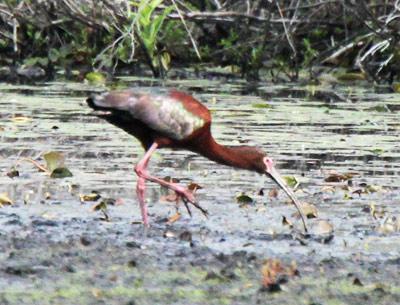Nature Notes: On Barcelona

Orioles, towhees, great-crested flycatchers, rose-breasted grosbeaks, catbirds, and a ton of warblers have all come back to roost. The most spectacular avian visitor in a while was the white-faced ibis that was seen and photographed at Scoy Pond in the Grace Estate nature preserve over the weekend by and Pat Lindsey and Angus Wilson.
The unseasonal coolness of May has slowed the advance of spring. We are just about back to normal and the drought shows signs of giving way to a precipitous late spring. Mosquitoes are beginning to hatch out and ticks are running amok. On Sunday afternoon I took out my tick flag, nothing more than an old white towel, suspended from the end of a snow shovel and went about ticking. The grassy spot on the southwest side of Route 114 just north of Stephen Hand’s Path was the perfect spot to put it to the test.
Holding the makeshift tick sampler in front of me, I walked through the two-foot-high lush grass and at the end of two minutes I had 29 ticks. You might be surprised to hear how they sorted out: 28 Lone Star ticks, 1 female deer tick, and 0 dog ticks. A little more than half of the Lone Star ticks were nymphs, pinhead-size. There was one adult male and the rest were adult females, the ones with the white spot, the “Lone Star,” on the back. The results were not unexpected as the Lone Star tick, Amblyoma americana, has become the dominant tick in this millennium, greatly outnumbering the other two.
Just think, it wasn’t even here in the 1980s, showed up in Montauk and on Gardiner’s Island and Fire Island in the early 1990s, and has mushroomed into the super tick. The nymphs and adult females are the chief carriers of the bacteria that cause ehrlichiosis. Expect the incidence of this disease, which can be very serious, even fatal, to grow by leaps and bounds, perhaps even rivaling the incidence of Lyme disease by 2020.
Aside from the ticks and the beginning of the mosquito season, the South Fork’s outback is resplendent. In terms of foliage and flowers, but, oh yes, pollen, the spring’s colors have been magnificent. While the shads, dogwoods, and beach plums were all in bloom by the end of April and the oaks of the black and red oak group were atypically in full leaf by the end of the first week in May, the white oaks, sassafras, hickories, and tupelos have behaved more normally. They are as late to leaf out as in other springs. What we see when we drive along the back roads is a freshly verdant green haze, which more than compensates for the ticks and the other things that make up spring’s downside.
A Friday afternoon walk on Barcelona, né Russell’s Neck, proved just how uplifting spring in the Hamptons can be. Admiral butterflies were courting, wildflowers were bursting forth, birds were singing, ospreys were anticipating the hatching of eggs, yellowlegs and egrets of two species were about in the marshes, fish crows and common crows cawed overhead, and, save for a few golfers on the golf course, there were no humans.
We stopped along the west trustee trail here and there to view the many different flowers: yellow cinquefoils, purple violets, white strawberries, blue-eyed grasses, lavender beach peas, and many more. The most spectacular of them all and the ones we most wanted to see were the rare wild pinks, which manage to burst forth at precisely the same time each spring on Barcelona. They are a rarity on Long Island and on the New York State Heritage List. Thank you, Mr. and Mrs. Deer for sparing them.
The bluffs at the north end of Barcelona continue to erode away into Northwest Harbor, but as they do, they grow taller. How is that? It turns out it’s not the bluff crest that grows higher, its the swelling dunes on top of them. Not all of the erosive sediments wash out to sea; a good lot of them are blown up the exposed bluff faces by winter’s northwest winds, then settle on top. Here they sit, no more than 100 feet apart — three dunes from west to east, each one taller than the last in line, the easternmost one reaching 50 feet high.
Walking dunes, bluff-crest dunes, perched dunes. Call them what you will, but they are a geologic oddity that is extremely rare along both coasts where high bluffs hold sway. Unfortunately, just as we were standing atop the highest dune and praising its majesty while listening to the uplifting song of the prairie warbler, two low-flying helicopters flew over on their way to East Hampton Airport, almost destroying what had been a glorious late afternoon.
Ancient geology, new geology, seas, shores, beaches, upland forest, tidal wetlands, freshwater wetlands, Indian relics, age-old trails, rare wild flowers, and spectacular views, Barcelona has it all. It was only 25 years ago when a certain Mr. Ben Heller tried to develop Russell’s Neck and build on the order of 75 houses on it, all with spectacular water views. Thank God and then-New York State Governor Mario Cuomo for the state’s purchase of it. Mr. Heller made off with a bundle, but in the final analysis, the acquisition was certainly well worth the cost. I feel certain that the Russells resting peacefully in their little cemetery not more than a stone’s throw away from the clubhouse would much prefer the Barcelona as it stands today to having it become just another dull and dreary replica of western Suffolk and Nassau Counties. And they probably would not be pleased as the whirlybirds roared over, shattering their quiet slumber.
